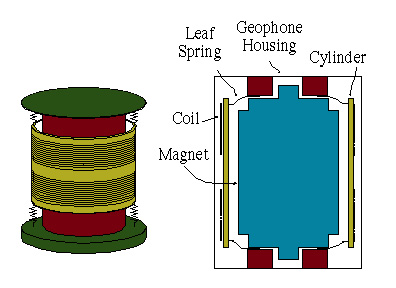



Figure 1: An isometric and cross-sectional view of a geophone
However, a geophone is typically only used for high frequency (4Hz-400Hz) seismology experiments because its resolution degrades at low frequency. The poor low frequency (10 mHz-1Hz) performance arises because the output is proportional to the velocity of the proof mass, in this case the cylinder and coil assembly. We have been investigating methods to improve the performance of a geophone through feedback and position sensing in various combinations.
The sensitivity of a geophone as a function of frequency can be altered by feeding back the conventional output. This will not improve the resolution, but will amplify low frequency signals. However, the resolution can be improved by measuring proof mass position. Currently, we are been building and testing capacitive geophones to demonstrate an affordable, broadband seismometer.
| Seismological Society of America
1999 Annual Meeting "An Affordable Broadband Seismometer:The Capacitive Geophone" | ||
|---|---|---|
| At this meeting, we presented results on the performance of a capacitive geophone based on the OYO Geospace GS-11D 4.5 Hz vertical geophone. A new circuit is used, which has been fabricated on a printed circuit board(PCB). The acceleration sensitivity is 63 V/g from 83 seconds to 50 Hz, while the velocity output has a sensitivity of 6.3 V/m/s from 45 sec to 50 Hz. The sensitivity has been verified experimentally down to .2 Hz and up to the high frequency rolloff. Resolution measurements have been taken, but they are limited by the ambient noise present during the measurement. Nevertheless, it sets an upper limit on the resolution. | ||
| Poster | 5/4/99 | Slides in Powerpoint(Mac 4.0)
format Slides in PDF format |
| Circuit Schematics | 5/4/99 | Part I,Position Measurement circuit, in PDF format Part II,Controller circuit, in PDF format |
| ASME International Congress
Winter '98 "Improving the Performance of a Geophone through Capacitive Position Sensing and Feedback" | ||
|---|---|---|
| At this meeting, we presented preliminary results on the performance of a capacitive geophone based on the Mark Products L-40 40 Hz geophone. While the results demonstrate the principle, more work needs to be done. The talk (not the manuscript) is the first presentation where we measure the phase of the signal on the center electrode, rather than the magnitude. | ||
| Talk | 11/20/98 | Slides & notes in Powerpoint(Mac 4.0)
format Slides in PDF format Notes in PDF format |
| Manuscript | 7/7/98 | Manuscript in PDF format Manuscript in Postscript format |
| Review of
Scientific Instruments "Technique for measurement of the noise of a sensor in the presence of large background signals" | ||
|---|---|---|
| This paper describes a method to measure the resolution of a sensor in the presence of large background signals. We use this technique to measure the resolution of the seismometers we build. If our lab were a quiet environment, we would just operate one instrument without exciting it to measure the sensor's noise. However, we are trying to build sensors whose resolution is better than 100 ng/rootHz. The background seismic signal in our lab is typically over 1 micro-g/rootHz. Therefore, when operating one of our sensors without applying an input, we measure the background seismic signal, not the sensor's noise. We avoid this problem, as described in the paper, by operating two identical sensors side-by-side and measuring the fraction of the output that is incoherent. Since the sensors are excited by the same signal, the small amount of incoherence is caused by sensor noise. | ||
| Manuscript | 7/98 | Manuscript in PDF format on RSI website |
| AGU Spring '98 "Improved Low Frequency Performance of a Geophone" | ||
|---|---|---|
| This is the first presentation we gave on capacitive geophones. It presents background information, the concept of a capacitive geophone, and a theoretical analysis of the sensitivity and resolution of a capacitive geophone. At this point we were measuring the magnitude of the signal of the center electrode (see ASME Winter'98 talk) rather than correctly measuring the phase. This poster does not present experimental measurements of a capacitive geophone. | ||
| Poster | 5/28/98 | Slides & notes in Powerpoint(Mac 4.0)
format Slides & notes in PDF format |